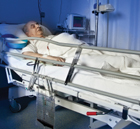
Interventions such as group training sessions and the provision of supportive materials for staff, residents and relatives can help nursing homes reduce dependence on physical restraints, a new study finds.
Currently, more than 20% of U.S. nursing homes use physical restraints, according to the study’s authors.
Researchers examined 36 nursing homes in two different German cities over a six-month period in a controlled trial. The rates of physical restraints in both groups were similar at the beginning of the study —32% in the intervention group and 31% in the control group.
In the intervention program, nurses were taught best practices to prevent restraint use and were given information on current research findings. They also were instructed on behavioral alternatives to restraints. Control group participants received standard information on the use of restraints.
At the end of the study, use of restraints dropped to 23% in the intervention group and 29% in the control group.
A survey administered upon the study’s completion indicated the nurses who were in the intervention group changed their attitude and the “institutional culture” around restraint use, the investigators wrote. They found that case discussion, counseling and education of relatives, and support from head nurses were some of the keys to success, while barriers included organizational problems such as staff fluctuation.
The study was published in the Journal of the American Medical Association.
From the July 01, 2012 Issue of McKnight's Long-Term Care News





